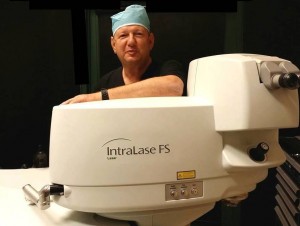LASIK Laser Vision Correction
LASIK can truly change your life. You can experience the freedom of seeing clearly when playing sports, swimming, even something as simple as seeing the alarm clock when getting up in the morning.
Laser vision correction was first approved in America by the Food and Drug Administration in November 1995, although, the first laser procedure was performed in Germany back in 1987.
The LASIK Procedure
LASIK (Laser in-Situ Keratomileusis) is a two-step process, combining sophisticated techniques to correct nearsightedness, farsightedness and/or astigmatism.
Dr. Newman provides his patients with two different options for the first step of the LASIK procedure. The first technique is what we called traditional LASIK surgery and involves the use of an automated instrument, the Microkeratome to create a thin protective layer of corneal tissue (flap) that covers the area to be sculpted by the laser. This flap allows for rapid recovery of vision and reduces discomfort after the procedure.
 The second technique eliminates the use of a blade to create a flap and replaces it with a laser called the IntraLase. This computer-controlled blade-free LASIK technology delivers rapid pulses of light, to a pre-programmed depth and position within the cornea. Each pulse forms a microscopic bubble. As the IntraLase laser moves back and forth across the eye, the bubbles are then connected to form the corneal flap. The blade-free IntraLase procedure enables Dr. Newman to precisely program and control many aspects of the flap itself, such as its thickness, its circumference, and the angle of its edges, effectively customizing the flap to the individual patient’s eye. This is of particular benefit to patients who have steep, flat, or thin corneas, as they may not have been candidates for traditional LASIK surgery in the past.
The second technique eliminates the use of a blade to create a flap and replaces it with a laser called the IntraLase. This computer-controlled blade-free LASIK technology delivers rapid pulses of light, to a pre-programmed depth and position within the cornea. Each pulse forms a microscopic bubble. As the IntraLase laser moves back and forth across the eye, the bubbles are then connected to form the corneal flap. The blade-free IntraLase procedure enables Dr. Newman to precisely program and control many aspects of the flap itself, such as its thickness, its circumference, and the angle of its edges, effectively customizing the flap to the individual patient’s eye. This is of particular benefit to patients who have steep, flat, or thin corneas, as they may not have been candidates for traditional LASIK surgery in the past.
After the flap is created, the second part of the procedure uses the excimer laser to sculpt the underlying cornea, correcting the refractive error. Once the surgery is finished, the eye is not patched, but a protective shield is placed over the eye to prevent inadvertent rubbing of the eye. Visual recovery is typically rapid, and there is little or no post-operative pain. Eye drops, including an antibiotic and steroid are taken for a week.
Only a LASIK expert can determine whether traditional LASIK or the blade-less IntraLase method will be right for you. Due to the many differences in technologies and your individual vision correction needs, Dr. Newman and the staff at Newman Eye Center will discuss all of the options available to you in order to safely correct your vision and give you the best possible outcome.
History
In 1989, Ioannis Pallikaris performs laser ablation under a flap of cornea and coined the acronym “LASIK” (Laser Assisted In Situ Keratomileusis).
For more information about LASIK surgery, please click here .
LASIK at the Newman Eye Center
Our laser was provided by Sightpath Medical.
Thank you for considering the Newman Eye Center for your LASIK procedure. Call today for a free screening to see if you’re a candidate for the LASIK procedure.
